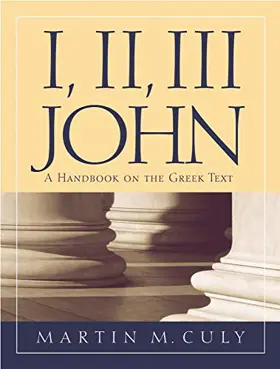

1, 2, 3 John: A Handbook on the Greek Text
in Baylor Handbook on the Greek New Testament
Pages
199 pages
Publisher
Baylor University Press
Published
2004
ISBN-13
9781932792089
In this volume Culy provides a basic lexical, analytical and syntactical analysis of the Greek text of 1, 2, and 3 Joh—information often presumed by technical commentaries and omitted by popular ones. But more than just an analytic key, I, II, III John reflects the latest advances in scholarship on Greek grammar and linguistics. The volume also contains recommendations for further reading and an up-to-date bibliography. A perfect supplement to any commentary, I, II, and III John is as equally helpful to language students, of any level, as it is to busy clergy who use the Greek text in preparation for proclamation.
Collections
This book appears in the following featured collections.
- The Pastor’s Bookshelf by Scot McKnight
Reviews
This book is a running commentary on the syntax of the letters of John, identifying grammatical categories for virtually every word. The English paragraph is printed, followed by each verse in Greek, then each phrase in the verse with commentary. For some words or phrases Cully points out that “scholars differ,” providing the various options for the student to sort out. Only rarely does Cully cite a particular grammar, which has the advantage of allowing professors to use whatever intermediate grammar they choose. The book is certainly a handy size, making it an easy read along side the Greek New Testament.
[Full Review]
A fresh approach from Baylor, one rooted in observations of the Greek text, begins with Martin Culy
[Full Review]
This book on 1, 2, and 3 John was written with the purpose of providing a “reliable guide through the intricacies of the biblical text and occasionally shed fresh light on how the Greek language works” (vii). The book starts with a rather brief introduction (xi–xxiv) in which the reader is informed about the purpose and approach taken. The reader is warned not to expect an “endeavor to label exhaustively every feature of the syntax” or a discussion of “every textual problem” or analyses of “all lexical forms.” However, an attempt is made to “address all significant questions arising from the Greek text itself.” Since more complex issues related to the Greek syntax are often ignored by the standard commentaries, this book tries to fill that particular gap in the available literature. However, the book is written both for people with just a basic knowledge of the Greek language as well as for the more advanced scholar. Since the focus falls on the linguistic characteristics of the text of the Letters, questions of introduction (e.g., author, date) are not discussed; neither is the theological meaning of the text explored. The introduction does, however, offer discussions on the genre and structure of the relevant text, tense, aspect, and mood, mitigated exhortations, deponency, syntactic categories and labels, and Trinitarian ambiguity. These discussions are brief and by no means comprehensive or exhaustive. Some of the most recent discussions on aspect and mood are, for instance, reflected, but the discussion only reflects a part of the particular debate.
[Full Review]


